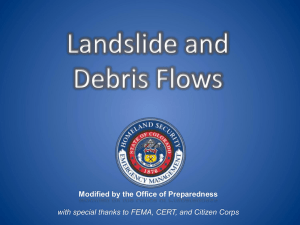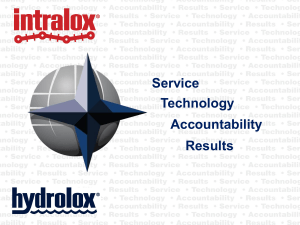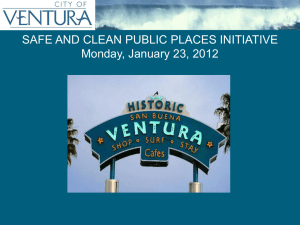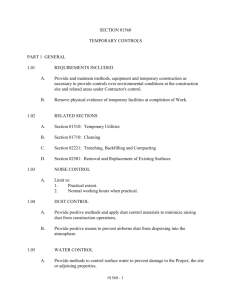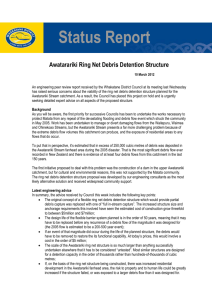Sample Health and Safety Strategy
advertisement
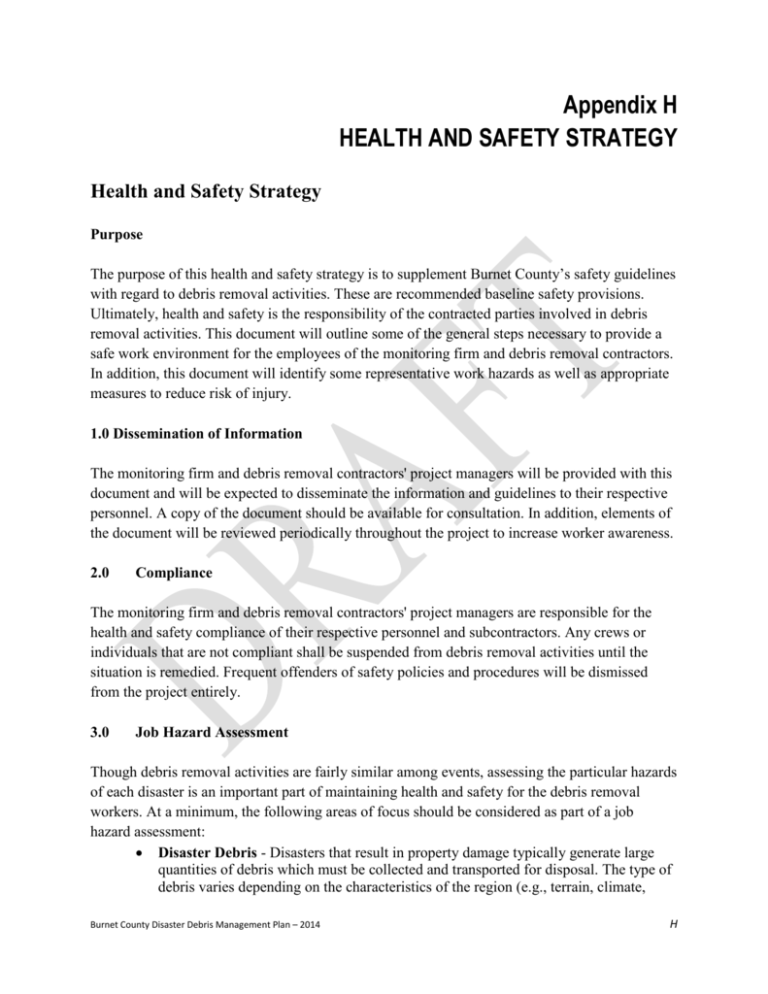
Appendix H HEALTH AND SAFETY STRATEGY Health and Safety Strategy Purpose The purpose of this health and safety strategy is to supplement Burnet County’s safety guidelines with regard to debris removal activities. These are recommended baseline safety provisions. Ultimately, health and safety is the responsibility of the contracted parties involved in debris removal activities. This document will outline some of the general steps necessary to provide a safe work environment for the employees of the monitoring firm and debris removal contractors. In addition, this document will identify some representative work hazards as well as appropriate measures to reduce risk of injury. 1.0 Dissemination of Information The monitoring firm and debris removal contractors' project managers will be provided with this document and will be expected to disseminate the information and guidelines to their respective personnel. A copy of the document should be available for consultation. In addition, elements of the document will be reviewed periodically throughout the project to increase worker awareness. 2.0 Compliance The monitoring firm and debris removal contractors' project managers are responsible for the health and safety compliance of their respective personnel and subcontractors. Any crews or individuals that are not compliant shall be suspended from debris removal activities until the situation is remedied. Frequent offenders of safety policies and procedures will be dismissed from the project entirely. 3.0 Job Hazard Assessment Though debris removal activities are fairly similar among events, assessing the particular hazards of each disaster is an important part of maintaining health and safety for the debris removal workers. At a minimum, the following areas of focus should be considered as part of a job hazard assessment: Disaster Debris - Disasters that result in property damage typically generate large quantities of debris which must be collected and transported for disposal. The type of debris varies depending on the characteristics of the region (e.g., terrain, climate, Burnet County Disaster Debris Management Plan – 2014 H dwelling and building types, population) and the debris-generating event (e.g. type, event strength, duration). In addition, the disaster debris produces a host of uneven surfaces which must be carefully negotiated. 4.0 Debris Removal- Often the removal of disaster debris involves working with splintered or sharp edges of vegetative or construction material debris. Many disasters involve heavy rains or flooding. Consequently, disaster debris is damp and heavier than usual. As weights increase, so does the risk of injury. Removal Equipment - In most disasters, debris must be removed from the public right-of-way (ROW) to provide access for emergency vehicles and subsequent recovery efforts. Debris collection and removal requires the use of heavy equipment and power tools to trim, separate and clear disaster debris. Traffic Safety - The ROW is located primarily on publicly maintained roads. As a result, much of the debris removal process takes place in traffic of varying levels of congestion. In addition, disasters often damage road signs, challenging safety on the road. Wildlife Awareness - Disasters are traumatic events for people as well as wildlife. Displaced animals, reptiles and insects pose a hazard to debris removal workers. Debris Disposal - After disaster debris is collected it is often transported to a Debris Management Site (DMS). Upon entry to a DMS, the monitoring firm will assess the volume of disaster debris being transported. The collection vehicle will then dispose of the disaster debris, at which time the debris will be reduced either through a grinding operation or incineration. The DMS is a common area for injury. Response and recovery workers in this environment are more likely to be exposed to falling debris, heavy construction traffic, noise levels, dust and airborne particles from the reduction process. Climate - Debris-generating disasters often occur in areas or seasons with extreme weather conditions. The effects of temperature and humidity on physical labor must be monitored, and proper work-rest intervals must be assessed. Administrative and Engineering Controls The use of administrative and engineering controls can greatly reduce the threats to public health and safety in debris removal activities. The following are some of the common administrative and engineering controls used in the debris removal process: Collection Operations Conduct debris removal operations during daylight hours only. Limit cleanup operations to one side of the road at a time. Limit collection work under overhead lines. Burnet County Disaster Debris Management Plan – 2014 H Inspect piles before using heavy equipment to remove them in order to ensure that there are no hazardous obstructions. Make sure that all collection vehicles have properly functioning lights, horns and backup alarms. Load collection vehicles properly to guard against overloading or unbalancing. Cover and secure loads, if necessary. When monitoring the collection process, stay alert in traffic and use safe driving techniques. Power Tools Inspect all power tools before use. Do not use damaged or defective equipment. Use power tools for their intended purpose. Avoid using power tools in wet areas. Debris Reducing Machinery (e.g .• Grinders/Wood Chippers) Do not wear loose-fitting clothing. Follow the manufacturer's guidelines and safety instructions. Guard the feed and discharge ports. Do not open access doors while equipment is running. Always chock the trailer wheels to restrict rolling. Maintain safe distances. Never reach into operating equipment. Use lock out/tag out protocol when maintaining equipment. Debris Management Site/Disposal Operations 5.0 Use jersey barriers and cones to properly mark traffic patterns. Use proper flagging techniques for directing traffic. Monitor towers must not exit into traffic and should have hand and guard rails to reduce trips and falls. Monitor towers must have properly constructed access stairways with proper treads and risers and proper ascent angle (4: 1 height/width ratio). Monitor towers must be surrounded by jersey barriers which protect the tower and monitors from being struck by inbound or outbound collection vehicles. Monitor towers should be located upwind from dust- and particulate generating activities. A water truck should spray the site daily to control airborne dust and debris when needed. Personal Protective Equipment Burnet County Disaster Debris Management Plan – 2014 H Personal Protective Equipment (PPE) is the last resort in providing a safe working environment for employees. PPE does not eliminate or even reduce hazards as administrative and engineering controls do. PPE works to reduce the risk of injury by creating a protective barrier between individuals and workplace hazards. PPE should only be used for its intended purpose. For example, using the wrong type of respirator might expose the worker to carcinogenic particulates. Properly fitting the equipment to the user may require examination by a medical professional. PPE that does not fit well will not provide maximum protection and will decrease the likelihood of the individual continuing to use the equipment. Furthermore, improper use may result in serious injury or death. The proper use of the equipment is outlined in detail in the manufacturer's instructions. The following PPE may be applicable in standard ROW; right-of-entry (ROE); vegetative and construction and demolition debris removal activities: Head Protection - This includes equipment designed to provide protection for an individual's head against hazards such as falling objects or the possibility of striking one's head against low hanging objects. PPE used to protect the head must comply with ANSI Z89.1-1986, "American National Standard for Personnel Protection - Protective Headwear for Industrial Workers -Requirements." Foot Protection - This includes equipment designed to provide protection for an individual's feet and toes against hazards such as falling or rolling objects, objects that may pierce the sole or upper section of the foot, etc. PPE used to protect the feet and toes must comply with ANSI Z-41-1991, "American National Standard for Personal Protection - Protective Footwear." Hand Protection - This includes equipment designed to provide protection for an individual's hands against hazards such as sharp or abrasive surfaces. The proper hand protection necessary is dependent upon the situation and characteristics of the gloves. For instance, specific gloves would be used for protection against electrical hazards, while the same gloves may not be appropriate in dealing with sharp or abrasive surfaces. Vision/Face Protection - This includes equipment designed to provide protection for an individual's eyes or face against hazards such as flying objects. PPE used to protect eyes and face must comply with ANSI Z87.1- 1989, "American National Standard Practice for Occupational and Educational Eye and Face Protection." Again, the type of eye/face protection necessary is dependent upon the situation and characteristics of the equipment. For instance, eye and face protection used by individuals who are welding may not be appropriate for individuals operating a wood chipper. Hearing Protection - This includes equipment designed to provide protection for an individual's hearing against prolonged exposure to high noise levels. According to the Occupational Safety and Health Administration (OSHA), the permissible level of sound is an average of 90 decibels over the course of an eight hour work day. For anything above the permissible sound exposure level, hearing protection is required. PPE used to protect hearing must comply with ANSI S3.19-1974, "American National Standard Practice for Personal Protection - Hearing Protection." Respiratory Protection - This includes equipment designed to provide protection for an individual's respiratory system against breathing air contaminated with hazardous gases, Burnet County Disaster Debris Management Plan – 2014 H vapors, airborne particles, etc. PPE used to protect the respiratory system must comply with ANSI Z88.2-1992. In addition, the use of respiratory protection requires a qualitative fit test and in some cases a pulmonary fit test by a licensed medical professional. 6.0 Personal Protective Equipment Debris Removal Activity PPE requirements are made based upon the results of the job hazards assessment. The following list of PPE is organized by debris removal activity and is meant to be a representative list. Specific PPE requirements vary from location to location. In general, individuals involved in the debris removal process should personally monitor water consumption to avoid dehydration and use appropriate skin protection (e.g., breathable clothes, light colors, sunscreen). Ultimately, the selection of PPE is the responsibility of the monitoring firm and debris removal contractors' project managers. Debris Collection Monitoring The hazards of disaster debris collection monitoring include, but are not limited to, being struck by vehicles; falls or trips on uneven surfaces; cuts, abrasions or punctures from vegetative or C&D sharps. PPE requirements include the following: Reflective vest Foot protection (e.g., rugged shoes or boots, steel toe and shank, if required) Long pants Debris Disposal Monitoring The hazards of disaster debris disposal monitoring include, but are not limited to, being struck by or caught in between vehicles; falls or trips on stairs or uneven surfaces; cuts, abrasions or punctures from vegetative or C&D sharps; and being struck by falling disaster debris. Monitor towers must be equipped with a first aid kit. PPE requirements include the following: Reflective vest Foot protection (e.g., rugged shoes or boots; steel toe, if required) Long pants Hard hat Debris Removal The hazards of disaster debris removal include, but are not limited to, being struck by vehicles; falls or trips on uneven surfaces; cuts, abrasions or punctures from vegetative or C&D sharps; and airborne debris. PPE requirements include the following: Reflective vest Vision and hearing protection Foot protection (e.g., rugged shoes or boots; steel toe and shank, if required) Burnet County Disaster Debris Management Plan – 2014 H Long pants Hand protection (Note: Leather gloves required for persons handling debris.) Debris Disposal and Reduction The hazards of disaster debris disposal and reduction include, but are not limited to, being struck by or caught in between vehicles; falls or trips on uneven surfaces; cuts, abrasions or punctures from vegetative or C&D sharps; being struck by falling disaster debris; and airborne particles. PPE requirements include the following: Reflective vest Foot protection (e.g., rugged shoes or boots; steel toe, if required) Vision and hearing protection Long pants Hard hat Debris Cutting and Trim Work The hazards of disaster debris cutting and trimming work include, but are not limited to, being struck by or caught in between vehicles; falls or trips on uneven surfaces; cuts, abrasions or punctures from power tools, vegetative or C&D sharps; being struck by falling disaster debris; and airborne particles. PPE requirements include: Reflective vest Hand and foot protection (e.g., rugged shoes or boots; steel toe, if required) Vision and hearing protection Long pants Gloves Hard hat For additional information regarding health and safety requirements, please contact OSHA. Health and Safety Contact Information Occupational Safety and Health Administration Burnet County Disaster Debris Management Plan – 2014 1-800-321-6742 1-512-374-0271 H


